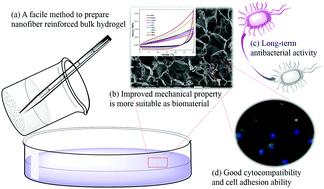当前位置:
X-MOL 学术
›
J. Mater. Chem. B
›
论文详情
Our official English website, www.x-mol.net, welcomes your feedback! (Note: you will need to create a separate account there.)
Nanofiber-reinforced bulk hydrogel: preparation and structural, mechanical, and biological properties
Journal of Materials Chemistry B ( IF 7 ) Pub Date : 2020-09-25 , DOI: 10.1039/d0tb01948h Yu Huang 1, 2, 3, 4, 5 , Xiufang Li 1, 2, 3, 4, 5 , Zhentan Lu 1, 2, 3, 4, 5 , Huan Zhang 1, 2, 3, 4, 5 , Jiangxi Huang 1, 2, 3, 4, 5 , Kun Yan 1, 2, 3, 4, 5 , Dong Wang 1, 2, 3, 4, 5
Journal of Materials Chemistry B ( IF 7 ) Pub Date : 2020-09-25 , DOI: 10.1039/d0tb01948h Yu Huang 1, 2, 3, 4, 5 , Xiufang Li 1, 2, 3, 4, 5 , Zhentan Lu 1, 2, 3, 4, 5 , Huan Zhang 1, 2, 3, 4, 5 , Jiangxi Huang 1, 2, 3, 4, 5 , Kun Yan 1, 2, 3, 4, 5 , Dong Wang 1, 2, 3, 4, 5
Affiliation

|
Alginate-based hydrogels are increasingly being used as biomaterials for tissue engineering, drug carriers, and wound dressing; however, their poor mechanical strength limits their applications. Nanofiber reinforcement is an effective method for increasing the mechanical strength of hydrogels. However, the macro preparation of nanofiber-reinforced hydrogels with a bulk structure is challenging. Herein, we describe the fabrication of nanofiber-reinforced bulk alginate hydrogel composites. The mechanical properties of hydrogels were significantly improved, and the reinforcement law of nanofiber was systematically studied. The maximum tensile stress (0.76 MPa) was obtained with 30% nanofiber content, which was 87% higher than that of pure alginate hydrogel. The compressive stress of the composite hydrogel exhibited “J-curve” behavior with gradually increasing nanofiber content, which indicated that the composited hydrogels were suitable as biomaterials. Furthermore, in 2 h, the hydrogels killed more than 90% of the bacteria that were present, and the bacteriostatic rate reached 100% after 12 h of treatment. More importantly, the sterile environment continued to be maintained, and the composited hydrogel also had satisfactory cytocompatibility and cell adhesion. Compared with pure alginate hydrogel, the roughness of the composited hydrogel surface was increased, which resulted in stronger cell adhesion. Therefore, the composite hydrogel demonstrated improved mechanical and biological properties, and exhibited the potential for clinical application.
中文翻译:

纳米纤维增强的整体水凝胶:制备及其结构,机械和生物学特性
基于藻酸盐的水凝胶正越来越多地被用作组织工程,药物载体和伤口敷料的生物材料。但是,它们的机械强度差限制了它们的应用。纳米纤维增强是提高水凝胶机械强度的有效方法。然而,具有本体结构的纳米纤维增强水凝胶的宏观制备具有挑战性。在这里,我们描述了纳米纤维增强的整体藻酸盐水凝胶复合材料的制造。水凝胶的力学性能得到明显改善,并且系统研究了纳米纤维的增强规律。当纳米纤维含量为30%时,最大拉伸应力(0.76 MPa)比纯藻酸盐水凝胶高87%。复合水凝胶的压缩应力表现为“ J纳米纤维含量逐渐增加的“弯曲”行为,表明复合水凝胶适合作为生物材料。此外,在2小时内,水凝胶杀死了超过90%的细菌,处理12小时后抑菌率达到100%。更重要的是,无菌环境得以继续保持,并且复合水凝胶也具有令人满意的细胞相容性和细胞粘附性。与纯藻酸盐水凝胶相比,复合水凝胶表面的粗糙度增加,导致细胞粘附力增强。因此,复合水凝胶表现出改善的机械和生物学性能,并具有临床应用潜力。
更新日期:2020-10-08
中文翻译:

纳米纤维增强的整体水凝胶:制备及其结构,机械和生物学特性
基于藻酸盐的水凝胶正越来越多地被用作组织工程,药物载体和伤口敷料的生物材料。但是,它们的机械强度差限制了它们的应用。纳米纤维增强是提高水凝胶机械强度的有效方法。然而,具有本体结构的纳米纤维增强水凝胶的宏观制备具有挑战性。在这里,我们描述了纳米纤维增强的整体藻酸盐水凝胶复合材料的制造。水凝胶的力学性能得到明显改善,并且系统研究了纳米纤维的增强规律。当纳米纤维含量为30%时,最大拉伸应力(0.76 MPa)比纯藻酸盐水凝胶高87%。复合水凝胶的压缩应力表现为“ J纳米纤维含量逐渐增加的“弯曲”行为,表明复合水凝胶适合作为生物材料。此外,在2小时内,水凝胶杀死了超过90%的细菌,处理12小时后抑菌率达到100%。更重要的是,无菌环境得以继续保持,并且复合水凝胶也具有令人满意的细胞相容性和细胞粘附性。与纯藻酸盐水凝胶相比,复合水凝胶表面的粗糙度增加,导致细胞粘附力增强。因此,复合水凝胶表现出改善的机械和生物学性能,并具有临床应用潜力。



























 京公网安备 11010802027423号
京公网安备 11010802027423号